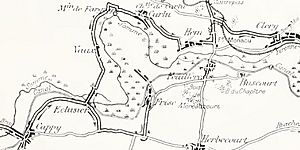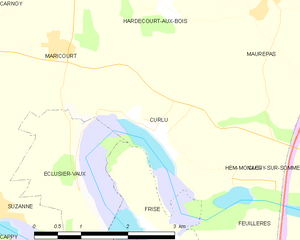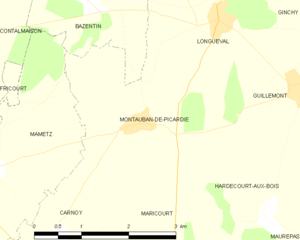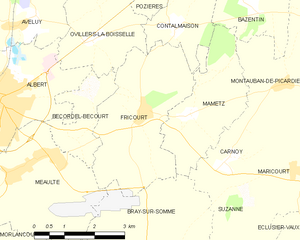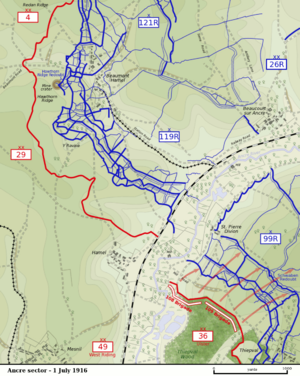First day on the Somme facts for kids
Quick facts for kids First day on the Somme |
|||||||
|---|---|---|---|---|---|---|---|
| Part of the Battle of the Somme (First World War) | |||||||
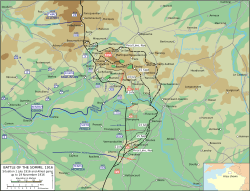 Battle of the Somme, 1 July – 18 November 1916 |
|||||||
|
|||||||
| Belligerents | |||||||
|
|
|||||||
| Commanders and leaders | |||||||
| Strength | |||||||
| 13 British divisions 6 French divisions |
6 divisions | ||||||
| Casualties and losses | |||||||
| British: 57,470 (19,240 killed) French: 1,590 |
6,226–12,000 | ||||||
| In the German ten-day casualty accounting period (10 tägigen Truppenkrankenrapporten) 1–10 July, 46,319 men became casualties and 7,539 men reported sick. | |||||||
The first day on the Somme, July 1, 1916, was the start of the Battle of Albert. This battle lasted for two weeks, from July 1 to July 13. It was part of the much larger Battle of the Somme, which went on for 141 days during the First World War.
On this day, French and British armies launched a massive attack against the German 2nd Army. The fighting stretched across a wide area in France, near the Somme and Ancre rivers. The main goal was to capture German defensive positions.
South of the main road, the German defenses mostly broke down. The French army had great success on both sides of the Somme River. The British also did well in some areas, capturing villages like Montauban and Mametz.
However, the British attack north of the Albert–Bapaume road was very difficult. Many British soldiers were killed or wounded. German counter-attacks later in the day took back most of the ground lost in the north. The British attacks on places like Thiepval failed with heavy losses.
In the northern part of the battlefield, many British troops were shot down in the open area between the trenches, known as no man's land. The German army suffered big defeats south of the road. This forced them to retreat from some areas.
After the battle, temporary agreements were made to collect the wounded from no man's land. The British suffered a huge number of casualties, with over 57,000 soldiers killed or wounded. The French had far fewer casualties, and the Germans also suffered significant losses. The battle continued the next day. The first day of the Somme remains a very sad and controversial event in British history.
Contents
- Why the Battle Happened
- Getting Ready for Battle
- The Battle Begins
- What Happened Next
- Remembering the Day
- Brave Soldiers: Victoria Crosses
Why the Battle Happened
Planning the Attack
In 1915, the French commander, Joseph Joffre, held meetings with Allied leaders. They decided on a plan for all Allied armies to attack at the same time. The British army was to fight in northern France.
By early 1916, the Germans attacked Verdun, which was a major French fortress. This changed the plan for the Somme. Many French soldiers had to go to Verdun. So, the Somme offensive became mainly a British attack, with the French Sixth Army helping.
This battle was the first huge attack by the British Expeditionary Force (BEF). Many new divisions, made up of volunteer soldiers, joined the fight. These included "Pals battalions," where friends from the same towns joined up together.
The German army's leader, Erich von Falkenhayn, believed in holding their ground firmly. He thought that retreating would cause even more losses. Even though a big attack on the Somme was expected, he didn't send many extra troops there. He thought the main British attack would be further north.
New Ways of Fighting
French Army Tactics
By 1916, both sides knew that attacks would be slow and costly. The French army developed new instructions for attacking. They planned for battles to be very organized. Artillery would destroy enemy defenses, and then infantry would move in.
Artillery and infantry had to work together closely. Heavy guns would destroy strong points and villages. Lighter guns would target trenches and machine-gun nests. Long-range guns would try to stop German artillery from firing. Field artillery would cut barbed wire. During the attack, artillery would fire a moving wall of shells, called a barrage, in front of the advancing soldiers.
British Army Tactics
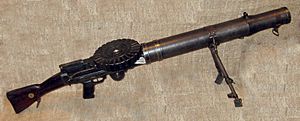
The British also learned from earlier battles. They understood how important artillery was. They planned to use "creeping barrages," where shells moved forward slowly, forcing the enemy to stay in their shelters. They also planned to use smoke screens and gas.
New weapons like Stokes mortars (light trench mortars) and Lewis guns (light machine-guns) were to be used. Communication systems were also improved. Soldiers were to advance in lines or "waves." Some waves would capture ground, and others would move through to continue the attack. Later, these waves were made thinner to reduce casualties.
German Army Defenses
The Germans had spent a lot of time building strong defenses on the Somme. They had huge barbed wire obstacles, sometimes 30 yards wide. Their front line had three trenches, dug far apart. These trenches had concrete posts and deep dugouts, 20 to 30 feet underground. These dugouts could hold 25 men and were meant to protect soldiers from shelling.
They also built an intermediate line of strongpoints behind the front line. A second main defensive position was built even further back. This was beyond the range of Allied field artillery. This meant attackers would have to stop and move their guns forward, giving the Germans time to prepare.
Getting Ready for Battle
Allied Preparations
Air Power
The British Royal Flying Corps (RFC) prepared for the battle. They used planes for scouting, bombing, and fighting German aircraft. They had many planes to observe the battlefield and direct artillery fire. The French also had a large air force helping.
British planes were meant to bomb German railways and supply depots. This would stop German supplies and reinforcements from reaching the front. They also attacked German observation balloons.
Artillery Power
The British brought many more artillery guns to the Western Front. The plan was to bombard the German lines for five days before the attack. They fired over 1.5 million shells during this time. On July 1, another 250,000 shells were fired. The sound of the guns could be heard very far away.
However, many of the British shells were not very good. Many failed to explode, or their fuses didn't work right. Shrapnel shells were not effective against deep trenches. The French army had more heavy guns and better high-explosive shells.
Cavalry and Infantry
The British had cavalry divisions ready to move forward if the attack broke through German lines. Their job was to exploit any success and protect the flanks. However, this plan relied on a big breakthrough, which didn't happen.
British infantry tactics involved advancing in waves. Soldiers carried a lot of equipment, including rifles, bayonets, ammunition, grenades, and tools. Some carried up to 66 pounds of gear. French infantry also used specialized groups, like "trench cleaners" with grenades and revolvers, to clear out remaining German defenders.
Underground Warfare

The chalky ground of the Somme was good for tunneling. British engineers dug 19 large mines under the German front lines. These mines were filled with huge amounts of explosives. The biggest ones contained 24 tons of explosives.
The mines were meant to destroy German defenses and create craters for British soldiers to hide in. Most were blown up two minutes before the attack. One famous mine, the Lochnagar mine, created a huge crater that can still be seen today.
Supplies and Logistics
The British army needed a massive amount of supplies. Railways brought in new divisions and heavy guns. Huge camps, workshops, and supply dumps were built behind the front lines. Roads and telephone networks were also constructed. Millions of shells and other supplies were delivered.
German Preparations
| Date | Rain mm |
°F/°C | |
|---|---|---|---|
| 23 | 2.0 | 79°–55° 26°–12° |
wind |
| 24 | 1.0 | 72°–52° 22°–11° |
dull |
| 25 | 1.0 | 71°–54° 22°–12° |
wind |
| 26 | 6.0 | 72°–52° 22°–11° |
cloud |
| 27 | 8.0 | 68°–54° 20°–12° |
cloud |
| 28 | 2.0 | 68°–50° 20°–10° |
dull |
| 29 | 0.1 | 66°–52° 19°–11° |
cloud wind |
| 30 | 0.0 | 72°–48° 22°–9° |
dull gale |
| 1 Jul | 0.0 | 79°–52° 26°–11° |
clear |
German units had been on the Somme front since 1914. They had built very strong defenses. Their dugouts were deep, sometimes 20 to 30 feet underground, to protect against shelling. They also had a good telephone system to link their artillery.
However, their defenses had weaknesses. Their front trenches were on a forward slope, easy for the Allies to see. Also, many of their troops were concentrated close to the front line. This meant they would face the full force of any artillery bombardment.
By mid-June, the Germans knew an attack was coming on the Somme. They saw more railway activity and new digging by the British. On June 24, a British prisoner confirmed a five-day bombardment would start. German air observers also saw many British observation balloons. Despite this, the Germans did not send many reinforcements to the Somme until the battle began.
The Battle Begins
French Army Attacks
South of the Somme River
South of the Somme River, the French XXXV Corps attacked two hours after the main British assault. The Germans thought a large French attack here was impossible. The French bombardment was very effective, destroying many German machine-guns.
When the French attacked, hidden by mist, the Germans were surprised. French artillery fired so many shells that the German artillery was almost silenced. The French also blew three mines under a German strongpoint. By the afternoon, the French had overwhelmed the German defenses. They captured about 2,000 prisoners and advanced about 2 kilometers.
North of the Somme River
North of the Somme, the French XX Corps attacked at 7:30 a.m. Their bombardment had destroyed many German fortifications. The moving barrage kept the Germans hidden. The French advanced well, except in a few places where the Germans put up strong resistance.
One German regiment suffered huge losses, with 1,809 casualties. The French captured 2,500 prisoners and advanced 1.5 kilometers. They didn't push further because the British on their flank hadn't advanced as far.
British Army Attacks
XIII Corps: Montauban
The XIII Corps attacked Montauban. The German defenses here were not as strong as further north. The British infantry advanced behind a moving barrage. French heavy artillery also helped. Much of the German artillery in this area was destroyed early on.
The British captured their objectives quickly. The 30th Division took its goals by 1:00 p.m., and the 18th (Eastern) Division finished by 3:00 p.m. The British suffered significant casualties, but the Germans in this sector also had very high losses.
XV Corps: Mametz and Fricourt
Mametz Village

The 7th Division attacked Mametz village. They advanced behind a creeping artillery barrage. The right side of the village was captured quickly. However, attempts to take the north and west ends were pushed back. After more shelling, the Germans retreated, and the village was taken.
The German regiment defending Mametz had been warned of the attack. Most of their soldiers were caught in deep shelters. Many machine-guns and artillery pieces were knocked out early. The 7th Division suffered 3,380 casualties.
Fricourt Village
Fricourt was in a bend of the German front line. The British XV Corps planned to attack around the village to trap the defenders. They blew three mines to help obscure the view from the village.
The 10th West Yorkshire Regiment, which advanced near Fricourt, suffered 733 casualties, the worst of any battalion that day. The German defenders were badly affected by the bombardment. The loss of Mametz and the British advance around Fricourt made the village impossible to hold. The Germans left Fricourt overnight. The 17th Division occupied it easily on July 2.
III Corps: La Boisselle and Ovillers
La Boisselle Village
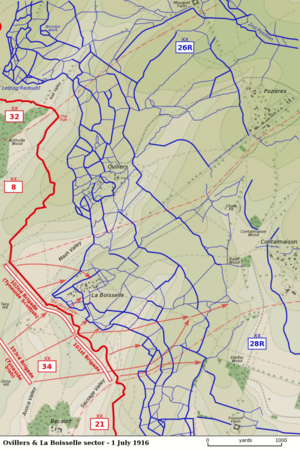
The 34th Division attacked along the Albert–Bapaume road. Two large mines, Lochnagar and Y Sap, were blown on either side of La Boisselle. The Y Sap mine caused no German casualties as they had left the area. The Lochnagar mine trapped some German troops.
Some British soldiers reached the Lochnagar crater but were then pinned down by German fire. A small group of British soldiers made the furthest British advance of the day, almost 4,000 yards, but they were later captured. The 34th Division suffered the most casualties of any division that day, with 6,380.
Ovillers Village
The 8th Division attacked Ovillers. They had to cross 750 yards of no man's land. The area was exposed to German guns from all sides. Some British troops reached the German second trench but were forced back.
The British artillery and infantry did not work well together here. The artillery lifted too early, leaving the German defenders free to fire on the advancing infantry. The Germans had machine-gun posts that survived the bombardment. The 8th Division suffered 5,121 casualties.
X Corps: Thiepval Area
Leipzig Salient and Thiepval Village
The 32nd Division attacked the Leipzig Salient and Thiepval village. British soldiers rushed the German front trench and captured the Leipzig Redoubt. This was the only lasting success in the northern sector.
However, attempts to push further were stopped by heavy machine-gun fire. The German defenders in Thiepval emerged from their shelters and fired on the British, creating a "wall of dead" in front of their positions. The 32nd Division suffered 3,949 casualties.
Schwaben and Stuff Redoubts
The 36th (Ulster) Division attacked between Thiepval and the Ancre River. They had a "spectacular victory." Their artillery bombardment was more successful here, and they used gas shells and smoke. The infantry crept into no man's land and rushed the German trenches.
They quickly overran the German positions, capturing the Schwaben Redoubt and getting close to Stuff Redoubt. However, the divisions on their flanks failed to advance. This left the Ulster Division exposed to German fire from three sides. German artillery then cut off the advanced Irish troops. Later, German counter-attacks forced the Irish out of the redoubt. The 36th (Ulster) Division suffered 5,104 casualties.
VIII Corps: Beaumont-Hamel and Serre
Beaumont-Hamel Village
The 29th Division attacked Beaumont-Hamel. A large mine was blown under Hawthorn Ridge Redoubt ten minutes before the attack. This warned the Germans. British troops failed to fully occupy the mine crater before Germans took over the far edge.
Many British soldiers were shot down in no man's land by German machine-guns. The Newfoundland Regiment, advancing from reserve, suffered terrible losses. Many were killed by German fire even before reaching their own front line. The Newfoundlanders suffered 710 casualties, a 91 percent loss. The 29th Division suffered 5,240 casualties.
Serre Village
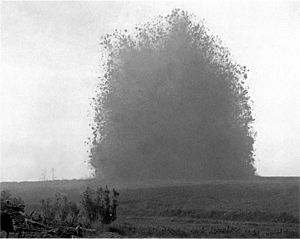
The 4th Division attacked between Serre and Beaumont-Hamel. They captured a strongpoint called the Quadrilateral but couldn't push further. Crossfire from Beaumont-Hamel and Serre stopped them. The 4th Division ended the day back at its starting line, with 5,752 casualties.
The 31st Division attacked Serre. They advanced uphill and were met by intense German machine-gun fire. Small groups reached Serre, and some even advanced 1.25 miles further, but they were cut off and killed or captured. The 31st Division suffered 3,600 casualties.
British Third Army: Gommecourt Diversion
The Third Army launched a diversionary attack at the Gommecourt Salient. This was meant to draw German attention away from the main attack. The 56th (1/1st London) Division made good progress, capturing the first three German trenches. However, a German barrage made it impossible for reinforcements to move up, and they were forced to retreat.
The 46th (North Midland) Division found that the German wire was not cut. A smoke screen meant to hide them actually blocked their view. Few troops reached the German trenches. The Germans were able to emerge from shelters and attack the British from behind. The 46th (North Midland) Division had the lowest divisional loss on July 1, with 2,445 casualties. The 56th (1/1st London) Division suffered 4,314 casualties.
Air Operations During the Battle
British aircraft observed the battle from above. They reported on the progress of the infantry and directed artillery fire. They also bombed German railways and supply depots. German aircraft tried to stop them, leading to some air battles.
Despite the efforts, accurate observation was difficult due to mist. Air observers reported the British successes in the south and the failures in the north. They saw German troops massing for counter-attacks.
What Happened Next
Casualties and Aftermath
The first day of the Somme was a disaster for the British army. Haig, the British commander, initially thought few soldiers had left their trenches in some areas, but over 14,000 men became casualties in just one corps. The British gained very little ground for such a huge loss of life. Only a small number of unwounded prisoners were taken.
Medical services struggled to cope with the huge number of wounded. Many were left in no man's land. Truces were sometimes arranged to collect the injured. The final British casualty count was 57,470, with 19,240 killed. The French Sixth Army suffered 1,590 casualties, and the German 2nd Army had between 10,000 and 12,000 casualties.
Continuing the Attack
Haig decided to continue the offensive on July 2. He wanted to keep pressure on the Germans and capture more ground. The plan was not changed much despite the heavy losses. Fresh divisions were brought in to relieve the exhausted troops.
On the night of July 1, the Germans tried to counter-attack. However, their attack was delayed until dawn on July 2. French and British troops easily stopped this counter-attack.
Remembering the Day
For Newfoundland, the first day of the battle was a turning point in its history. It ended hopes of independence for the island. After the war, the Newfoundland government bought land at the battle site. They created the Newfoundland Memorial Park to honor the dead. It opened in 1925. Even today, July 1 is Memorial Day in Newfoundland and Labrador, not Canada Day.
Brave Soldiers: Victoria Crosses
The Victoria Cross is the highest award for bravery in the British military. Several soldiers received this award for their actions on the first day of the Somme:
- Eric Bell, at Thiepval — awarded after his death.
- Geoffrey Cather, at Hamel — awarded after his death.
- John Green, a medic at Foncquevillers — awarded after his death.
- Stewart Loudoun-Shand, at Fricourt — awarded after his death.
- William McFadzean, at Thiepval Wood — awarded after his death.
- Robert Quigg, at Hamel.
- Walter Ritchie, at Beaumont Hamel.
- George Sanders, at Thiepval.
- James Turnbull, at Authuille — awarded after his death.




